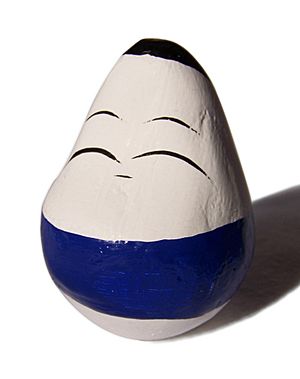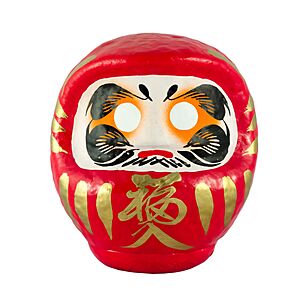Okiagari-koboshi facts for kids

The Okiagari-koboshi (pronounced Oh-kee-ah-gah-ree-koh-boh-shee) is a special Japanese traditional doll. Its name means "getting-up little boy." This doll is made from papier-mâché, which is a strong material made from paper and glue. It is a type of roly-poly toy, meaning it is designed to always stand back up if it gets knocked over. This happens because of how its weight is balanced. Okiagari-koboshi dolls are seen as a good-luck charm and a sign of never giving up, also known as perseverance and resilience.
What are Daruma Dolls?

Some Daruma dolls are very similar to Okiagari-koboshi dolls. They also stand back up whenever they are pushed over. These Daruma dolls are often linked to a famous Buddhist monk named Bodhidharma. A legend says that Bodhidharma meditated for nine years, which caused his legs to become weak or even fall off. This story helps explain why many Daruma dolls do not have legs.
In the 1600s, there was a children's song about these dolls. It showed that the Okiagari-koboshi Daruma dolls back then were much like the ones we see today:
Hi ni! fu ni!
Fundan Daruma ga
Akai zukin kaburi sunmaita!
Once! twice!
The red-hooded Daruma
Always sits up again!
How to Use a Daruma Doll
Many people buy paper mache Daruma dolls that do not have eyes drawn on them. These dolls are bought when someone has a special goal or wish in mind. When you start working towards your goal, you draw in the doll's left eye. Once you achieve your goal, you then draw in the right eye. For example, if someone hopes to get better from an illness, they might buy a Daruma doll for that purpose.

